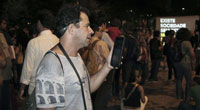Tuesday, April 16, 2024
News and Views from the Global South
Ninja Citizen Journalists Don’t Claim to Be Impartial
- The citizen journalists of Midia Ninja, who have covered the protests that broke out across Brazil in June right in the thick of things, are part of a new kind of reporting: one that is proud to be biased.

Cazú Barros participating in and reporting on a street protest in Rio de Janeiro, using a tablet. Credit: Fabiana Frayssinet/IPS
Just before the start of one of the latest protests, on Friday Sept. 20, “ninja” journalist Cazú Barros said he was worried that he needed a spare battery for his cell-phone, because he had to provide hours of live stream coverage of a debate outside the Rio de Janeiro legislature.
His equipment contrasted sharply with that of reporters from large radio and TV stations – who were not there, however, because of the mainstream media’s lack of interest in this kind of news. Barros has just a small camera on his 3G tablet, and uses an Android streaming app to provide live coverage.
“What strikes me the most about Midia Ninja is the way people search us out, because of our credibility,” he told IPS. “They don’t trust the traditional newscasts anymore, because they are tired of being manipulated.”
Ninja – an acronym for “independent narratives, journalism and action” in Portuguese – emerged two years ago in the southern Brazilian city of São Paulo as an initiative of the Fora do Eixo (off-axis) network of independent music collectives.
But it achieved unexpected visibility with the outbreak of the protests, which were triggered by bus and subway fare hikes but later expanded to target the political system, corruption and shortcomings in the health and educational systems. Many of the protesters are middle-class, and the demonstrations have come at a time of relative prosperity and declining poverty.
The Ninja protesters do not hesitate to follow and film a presumed police infiltrator or provocateur among the crowds of demonstrators. Through their live streaming, the activists-cum-journalists secured the release of a demonstrator who was wrongly arrested on charges of throwing a Molotov cocktail, because their footage proved he was innocent.
Midia Ninja’s work has also helped curtail police brutality because their “eyes”, which are everywhere, have shown the police beating peaceful protesters. “That was always our concern – providing a specific narrative of how we are feeling the streets as reporters,” said Felipe Peçanha, one of the founders of Midia Ninja, who was taken into custody for supposedly “inciting violence” but was released due to lack of evidence.
But Midia Ninja’s 200 volunteer citizen journalists covering events in Brazil’s main cities are not on their own. They have the support of their followers on the Twitter social network who, citing the @MidiaNINJA account, send out tweets, warning for example when riot police are approaching a certain spot.
At the peak of the protests, in June and July, Midia Ninja’s broadcasts reached some 180,000 people. The group’s Facebook page now has over 212,000 “likes”. “This is a form of media that has more freedom to tackle issues in a more integral manner,” one of the group’s followers, a student named Thiago Cavalcante, told IPS. “It doesn’t show just one side, as absolute truth, but presents all of the facts, and it lets the viewers put together their own reality, based on the images.”
Demonstrators have also expressed discontent with the mainstream media, especially TV. Some have thrown stones at the offices of Rede Globo, Brazil’s main TV station which is one of the biggest in Latin America, and have booed its journalists. In addition, broadcast vehicles of two other stations, SBT and Rede Record, were set on fire.
“The bias of the press has been challenged, because through the protests, Brazilian society has seen the media consortiums’ game of interests more clearly,” Peçanha said. “This became visible through the alternative coverage, but the protesters also saw it for themselves,” he added.
“After coming back from a protest, many would turn the TV sets on in their homes and see a very different story than the one they had witnessed themselves. And they started to understand that ‘something is wrong here’.” Midia Ninja and others involved in this fast-growing form of reporting see journalistic neutrality as a big lie.
Peçanha makes no secret of the fact that his aim is to accompany the social movements, which historically have not had a voice in most of the mainstream media. He argues, however, that the big media outlets are not “impartial” either, but answer to their own interests or those of the economic powers they represent – although less transparently, he says, than the new citizen journalists.
“Our work highlights the bias of the press, which should be increasingly evident, so people can have more honest contact with the news,” he added.
Surveys carried out by the Oops website found that the ratings of various news programmes dropped between Aug. 31, 2012 and Aug. 31, 2013. Audience share fell 41 percent in the case of Rede TVNews; 12 percent in the case of Globo’s Jornal Nacional and Bandeirantes’ Jornal da Band; 18 percent in the case of Bandeirantes’ Brasil Urgente; and six percent in the case of Jornal do SBT.

 Print
Print



